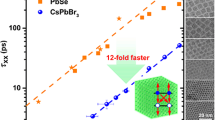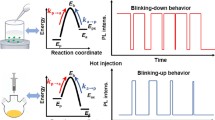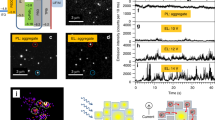Abstract
Multiple morphologies of colloidal perovskite nanocrystals (NCs) diversify their optical and electronic properties. Among them, the linear absorption cross-section (σ) is a primary parameter to determine their intrinsic photophysical features, and consequently, application potential. Herein, three morphologies of all-inorganic hybrid colloidal perovskite CsPbBr3 NCs, nanocubes (NBs), nanoplatelets (NLs), and nanowires (NWs), were targeted, and their linear σ values were obtained through femtosecond transient absorption (TA) spectroscopy analysis. At high excitation energy well above the bandgap, the σ per particle of all CsPbBr3 NCs linearly increased with the particle volume (VNC) regardless of the morphology with the value of σ400 = 9.45 × 104 cm−1 × VNC (cm2). Density functional theory (DFT) calculation confirmed the negligible influence of shapes on the optical selection rules. The Einstein spontaneous emission coefficients calculated from the σ values define the intrinsic radiative recombination rate. However, reduced size dependence is observed when the excitation energy is close to the bandgap (i.e., at 460 nm) with the value of σ460 = 2.82 × 108 cm0.65 × (VNC)0.45 (cm2). This should be ascribed to the discrete energy levels as well as lower density of states close to the band edge for perovskite NCs. These results provide in-depth insight into the optical characteristics for perovskite NCs.
摘要
胶体钙钛矿纳米晶的形貌变化赋予其不同的光学和电子特 性, 其中, 线性吸收截面是决定材料本征光物理特性及其应用潜力 的主要参数. 本文研究了三种不同形貌的全无机钙钛矿CsPbBr3纳 米晶(纳米立方体、纳米片和纳米线), 通过飞秒瞬态吸收光谱分析 了它们的线性吸收截面值σ. 在高于带隙的能量激发下, 单个 CsPbBr3纳米晶的吸收截面值与形貌无关, 且随着粒子的体积(VNC) 呈σ400 = 9.45 × 104 cm−1 × VNC (cm2)趋势变化. 密度泛函理论证实 了形貌对光学选择规则基本没有影响, 同时, 根据吸收截面值也计 算得到了定义本征辐射复合率的爱因斯坦自发辐射系数. 然而, 当 激发能接**带隙(460 nm)时, 吸收截面值对纳米晶尺寸的依赖关系 变弱, 取值满足σ460 = 2.82 × 108 cm0.65 × (VNC)0.45 (cm2), 这主要归因 于钙钛矿纳米晶的离散能级及靠**带边的较低的态密度. 本文的 研究结果为洞悉钙钛矿纳米晶的光学特性提供了深入的见解.
Similar content being viewed by others
References
Li X, Bi D, Yi C, et al. A vacuum flash-assisted solution process for high-efficiency large-area perovskite solar cells. Science, 2016, 353: 58–62
Stranks SD, Snaith HJ. Metal-halide perovskites for photovoltaic and light-emitting devices. Nat Nanotech, 2015, 10: 391–402
Snaith HJ. Present status and future prospects of perovskite photovoltaics. Nat Mater, 2018, 17: 372–376
Chen J, Du W, Shi J, et al. Perovskite quantum dot lasers. InfoMat, 2020, 2: 170–183
Protesescu L, Yakunin S, Bodnarchuk MI, et al. Nanocrystals of cesium lead halide perovskites (CsPbX3, X = Cl, Br, and I): Novel optoelectronic materials showing bright emission with wide color gamut. Nano Lett, 2015, 15: 3692–3696
Seth S, Samanta A. A facile methodology for engineering the morphology of CsPbX3 perovskite nanocrystals under ambient condition. Sci Rep, 2016, 6: 37693
Liang Z, Zhao S, Xu Z, et al. Shape-controlled synthesis of all-inorganic CsPbBr3 perovskite nanocrystals with bright blue emission. ACS Appl Mater Interfaces, 2016, 8: 28824–28830
Sun S, Yuan D, Xu Y, et al. Ligand-mediated synthesis of shape-controlled cesium lead halide perovskite nanocrystals via re-precipitation process at room temperature. ACS Nano, 2016, 10: 3648–3657
Di Stasio F, Imran M, Akkerman QA, et al. Reversible concentration-dependent photoluminescence quenching and change of emission color in CsPbBr3 nanowires and nanoplatelets. J Phys Chem Lett, 2017, 8: 2725–2729
Jeon S, Jung MC, Ahn J, et al. Post-synthetic oriented attachment of CsPbBr3 perovskite nanocrystal building blocks: From first principle calculation to experimental demonstration of size and dimensionality (0D/1D/2D). Nanoscale Horiz, 2020, 5: 960–970
Li Q, Lian T. Ultrafast charge separation in two-dimensional CsPbBr3 perovskite nanoplatelets. J Phys Chem Lett, 2019, 10: 566–573
Yang D, Zou Y, Li P, et al. Large-scale synthesis of ultrathin cesium lead bromide perovskite nanoplates with precisely tunable dimensions and their application in blue light-emitting diodes. Nano Energy, 2018, 47: 235–242
Shang Q, Li C, Zhang S, et al. Enhanced optical absorption and slowed light of reduced-dimensional CsPbBr3 nanowire crystal by exciton-polariton. Nano Lett, 2020, 20: 1023–1032
Zhang X, Wu X, Liu X, et al. Heterostructural CsPbX3-PbS (X = Cl, Br, I) quantum dots with tunable Vis-NIR dual emission. J Am Chem Soc, 2020, 142: 4464–4471
Chen J, Zhang Q, Shi J, et al. Room temperature continuous-wave excited biexciton emission in perovskite nanoplatelets via plasmonic nonlinear fano resonance. Commun Phys, 2019, 2: 80
Chen W, Zhang S, Zhou M, et al. Two-photon absorption-based upconverted circularly polarized luminescence generated in chiral perovskite nanocrystals. J Phys Chem Lett, 2019, 10: 3290–3295
Yang B, Han K. Charge-carrier dynamics of lead-free halide perovskite nanocrystals. Acc Chem Res, 2019, 52: 3188–3198
Maes J, Balcaen L, Drijvers E, et al. Light absorption coefficient of CsPbBr3 perovskite nanocrystals. J Phys Chem Lett, 2018, 9: 3093–3097
Puthenpurayil J, Cheng OHC, Qiao T, et al. On the determination of absorption cross section of colloidal lead halide perovskite quantum dots. J Chem Phys, 2019, 151: 154706
Chen J, Žídek K, Chábera P, et al. Size- and wavelength-dependent two-photon absorption cross-section of CsPbBr3 perovskite quantum dots. J Phys Chem Lett, 2017, 8: 2316–2321
Hens Z, Moreels I. Light absorption by colloidal semiconductor quantum dots. J Mater Chem, 2012, 22: 10406–10415
Chu S. Cold atoms and quantum control. Nature, 2002, 416: 206–210
Huang MH. Facet-dependent optical properties of semiconductor nanocrystals. Small, 2019, 15: 1804726
Htoon H, Hollingsworth JA, Dickerson R, et al. Effect of zero- to one-dimensional transformation on multiparticle auger re-combination in semiconductor quantum rods. Phys Rev Lett, 2003, 91: 227401
Ivanov SA, Achermann M. Spectral and dynamic properties of excitons and biexcitons in type-II semiconductor nanocrystals. ACS Nano, 2010, 4: 5994–6000
Wang Y, Li X, Song J, et al. All-inorganic colloidal perovskite quantum dots: A new class of lasing materials with favorable characteristics. Adv Mater, 2015, 27: 7101–7108
Zhang D, Yu Y, Bekenstein Y, et al. Ultrathin colloidal cesium lead halide perovskite nanowires. J Am Chem Soc, 2016, 138: 13155–13158
Pan A, He B, Fan X, et al. Insight into the ligand-mediated synthesis of colloidal CsPbBr3 perovskite nanocrystals: The role of organic acid, base, and cesium precursors. ACS Nano, 2016, 10: 7943–7954
Imran M, Di Stasio F, Dang Z, et al. Colloidal synthesis of strongly fluorescent CsPbBr3 nanowires with width tunable down to the quantum confinement regime. Chem Mater, 2016, 28: 6450–6454
Chen J, Messing ME, Zheng K, et al. Cation-dependent hot carrier cooling in halide perovskite nanocrystals. J Am Chem Soc, 2019, 141: 3532–3540
Zhang F, Chen J, Zhou Y, et al. Effect of synthesis methods on photoluminescent properties for CsPbBr3 nanocrystals: Hot injection method and conversion method. J Lumin, 2020, 220: 117023
Li Y, Ding T, Luo X, et al. Biexciton auger recombination in mono-dispersed, quantum-confined CsPbBr3 perovskite nanocrystals obeys universal volume-scaling. Nano Res, 2019, 12: 619–623
Wang L, Fu K, Sun R, et al. Ultra-stable CsPbBr3 perovskite nanosheets for X-ray imaging screen. Nano-Micro Lett, 2019, 11: 52
Zhou H, Song Z, Grice CR, et al. Self-powered CsPbBr3 nanowire photodetector with a vertical structure. Nano Energy, 2018, 53: 880–886
Makarov NS, Guo S, Isaienko O, et al. Spectral and dynamical properties of single excitons, biexcitons, and trions in cesium-leadhalide perovskite quantum dots. Nano Lett, 2016, 16: 2349–2362
Lenngren N, Garting T, Zheng K, et al. Multiexciton absorption cross sections of CdSe quantum dots determined by ultrafast spectroscopy. J Phys Chem Lett, 2013, 4: 3330–3336
Klimov VI, Mikhailovsky AA, McBranch DW, et al. Quantization of multiparticle auger rates in semiconductor quantum dots. Science, 2000, 287: 1011–1013
Ji M, Park S, Connor ST, et al. Efficient multiple exciton generation observed in colloidal PbSe quantum dots with temporally and spectrally resolved intraband excitation. Nano Lett, 2009, 9: 1217–1222
Shamsi J, Dang Z, Bianchini P, et al. Colloidal synthesis of quantum confined single crystal CsPbBr3 nanosheets with lateral size control up to the micrometer range. J Am Chem Soc, 2016, 138: 7240–7243
Yang D, Li X, Zhou W, et al. CsPbBr3 quantum dots 2.0: Benzenesulfonic acid equivalent ligand awakens complete purification. Adv Mater, 2019, 1900767
Wan W, Zhou YY, Yan L, et al. In situ compositing CsPbBr3 with exfoliated layered-perovskite CsCa2Ta3O10: Interfacial interaction and enhanced stability. ACS Appl Mater Interfaces, 2019, 11: 47227–47236
Goesten MG, Hoffmann R. Mirrors of bonding in metal halide perovskites. J Am Chem Soc, 2018, 140: 12996–13010
Leatherdale CA, Woo WK, Mikulec FV, et al. On the absorption cross section of CdSe nanocrystal quantum dots. J Phys Chem B, 2002, 106: 7619–7622
Brus LE. Electron-electron and electron-hole interactions in small semiconductor crystallites: The size dependence of the lowest excited electronic state. J Chem Phys, 1984, 80: 4403–4409
Hanamura E. Very large optical nonlinearity of semiconductor microcrystallites. Phys Rev B, 1988, 37: 1273–1279
Yu WW, Qu L, Guo W, et al. Experimental determination of the extinction coefficient of CdTe, CdSe, and CdS nanocrystals. Chem Mater, 2003, 15: 2854–2860
Cademartiri L, Montanari E, Calestani G, et al. Size-dependent extinction coefficients of PbS quantum dots. J Am Chem Soc, 2006, 128: 10337–10346
Moreels I, Lambert K, De Muynck D, et al. Composition and size-dependent extinction coefficient of colloidal PbSe quantum dots. Chem Mater, 2007, 19: 6101–6106
Leistikow MD, Johansen J, Kettelarij AJ, et al. Size-dependent oscillator strength and quantum efficiency of CdSe quantum dots controlled via the local density of states. Phys Rev B, 2009, 79: 045301
Hilborn RC. Einstein coefficients, cross sections, f values, dipole moments, and all that. Am J Phys, 1982, 50: 982–986
Yu P, Beard MC, Ellingson RJ, et al. Absorption cross-section and related optical properties of colloidal InAs quantum dots. J Phys Chem B, 2005, 109: 7084–7087
Prezhdo OV. Multiple excitons and the electron-phonon bottleneck in semiconductor quantum dots: An ab initio perspective. Chem Phys Lett, 2008, 460: 1–9
Fisher BR, Eisler HJ, Stott NE, et al. Emission intensity dependence and single-exponential behavior in single colloidal quantum dot fluorescence lifetimes. J Phys Chem B, 2004, 108: 143–148
Acknowledgements
This work was supported by the National Natural Science Foundation of China (NSFC, U1862111), China Scholarship Council (201706990062), Independent Research Fund Denmark-Nature Sciences (DFF-7014-00302), Independent Research Fund Denmark-Sapere Aude starting grant (7026-00037A), Swedish Research Council VR starting grant (2017-05337), grants VR2018-06011, and VR2018-05090, the Research Fund for international Young Scientists from NSFC, China (21950410515) and Swedish Energy Agency.
Author information
Authors and Affiliations
Contributions
Zhang F designed and engineered the samples; Liu Y, Wei S and Chen J assisted to perform the experiments; Zhou Y, He R and Pullerits T helped to modify the manuscript; Zheng K led the project.
Corresponding authors
Additional information
Conflict of interest
The authors declare that they have no conflict of interest.
Fengying Zhang received her PhD degree from Southwest University in 2019. During her PhD period, she studied at Lund University as a visiting PhD, dedicated to the study of material spectroscopy. Then, she joined the School of New Energy and Materials, Southwest Petroleum University as a lecturer, and has engaged in material-related scientific research.
Rongxing He is a professor at Southwest University, China. He received his PhD from Sichuan University in 2006. Then, he joined the School of Chemistry and Chemical Engineering, Southwest University. His main research interests include molecular spectroscopy and photochemistry, electrochemical catalysis and reaction mechanism, and photoelectric functional materials.
Tõnu Pullerits obtained his PhD degree in 1991 from the Institute of Physics at Tartu University, Estonia. He is currently full professor and head of the Chemical Physics Division at Lund University. He has been a member of the Royal Swedish Academy of Sciences since 2016. His research interests include energy transport in molecular systems, ultrafast charge carrier dynamics and photophysics in photovoltaic materials, and coherence multidimensional spectroscopy.
Kaibo Zheng obtained his PhD degree in 2010 from the Department of Materials Science at Fudan University. Then, he joined the Chemical Physics Division at Lund University, Sweden, as a postdoctoral fellow. He is currently a senior researcher in chemical physics, Lund University, and dual affiliated as a senior researcher at the Department of Chemistry, Technical University of Denmark. His research interests include the structure and photophysics of semiconductor and perovskite quantum dots as light harvesting materials.
Supplementary Information
Rights and permissions
About this article
Cite this article
Zhang, F., Liu, Y., Wei, S. et al. Microscopic morphology independence in linear absorption cross-section of CsPbBr3 nanocrystals. Sci. China Mater. 64, 1418–1426 (2021). https://doi.org/10.1007/s40843-020-1555-1
Received:
Accepted:
Published:
Issue Date:
DOI: https://doi.org/10.1007/s40843-020-1555-1




